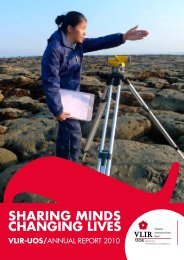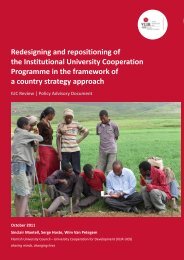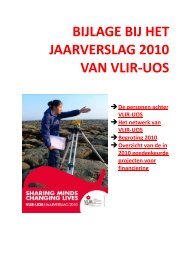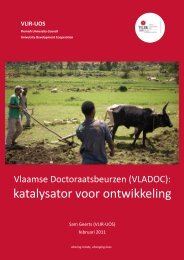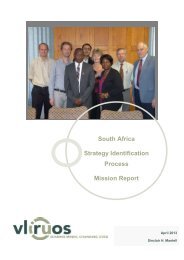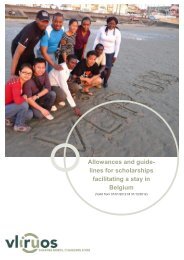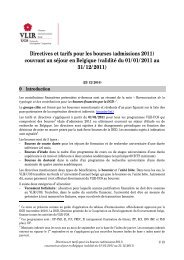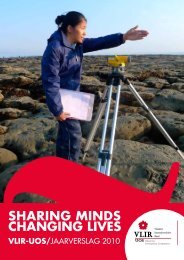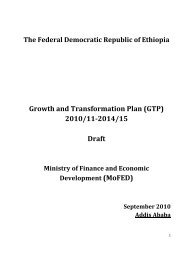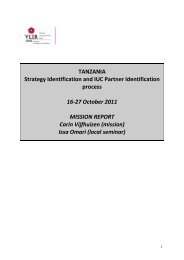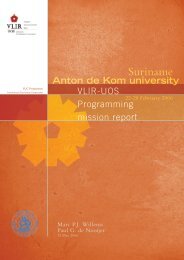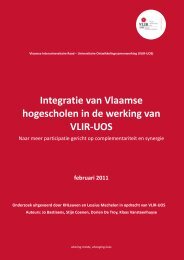Education Sector Development Program - VLIR-UOS
Education Sector Development Program - VLIR-UOS
Education Sector Development Program - VLIR-UOS
You also want an ePaper? Increase the reach of your titles
YUMPU automatically turns print PDFs into web optimized ePapers that Google loves.
<strong>Education</strong> <strong>Sector</strong> <strong>Development</strong> <strong>Program</strong> IV<br />
late entrance in grade 1, aggravated by continued<br />
repetition during both cycles and particularly<br />
during the second cycle. It is encouraging to see<br />
though that the Net Intake Rate (NIR) has been<br />
improving since 2004/05.<br />
Also a big gap remains between the enrolment<br />
rates in first cycle (1-4) and second cycle (5-<br />
8) primary. In 2008/2009 the GER first cycle<br />
(including ABE) was 122.6% as compared to only<br />
63.1% in the second cycle. This gap will receive<br />
attention during ESDP IV. Reasons for this<br />
low second cycle enrolment relate to the poor<br />
retention of learners during the first cycle, to the<br />
existence of several schools with poor facilities<br />
and to the distance between home and second<br />
cycle schools.<br />
The gap between boys and girls has continued<br />
declining and has become much smaller.<br />
For instance, in 2008/2009 the GER of girls in<br />
primary 1-8 was lagging behind that of boys by<br />
6.9 percentage points as compared to 16.5 points<br />
in 2004/05. However, regional disparities<br />
continue being large. Two regions, Somali and<br />
Afar are lagging far behind the others with a<br />
GER below 65%. The encouraging finding though<br />
is that Somali and Afar are also the two regions<br />
that had by far the highest average annual growth<br />
rates of enrolments in primary 1-8 since 2004/05<br />
of respectively 16.7 and 17.5%, as compared to a<br />
national average of 12.6%.<br />
In both regions the expansion of ABE centers<br />
played an important role in the increase of<br />
enrolments, but other alternative ways of<br />
providing education to pastoralist and semipastoralist<br />
populations (such as boarding<br />
schools, mobile schools, etc,) will be developed<br />
more strongly during ESDP IV. Further attention<br />
will have to be given to the design and adoption<br />
of sustainable alternative education modalities,<br />
including ways of facilitating the continuation of<br />
studies for learners who have completed ABE<br />
and find it difficult to join formal schools.<br />
Main challenges<br />
• In spite of a sustained increase<br />
of enrolments during ESDP III,<br />
a big gap remains between<br />
enrolments in first cycle (1-4)<br />
and second cycle (5-8)<br />
• The NER remains far below<br />
the GER in both cycles, which<br />
indicates a serious problem of<br />
late entrance and low internal<br />
efficiency<br />
• There is limited transition from<br />
ABECs to formal schools<br />
• ABEC is interpreted as a regular<br />
and long lasting program, while<br />
it should remain a short-term<br />
alternative<br />
• The gap between the emerging<br />
regions (Afar, Gambella and<br />
Somali) and other regions in<br />
access to primary education is<br />
still high<br />
• There is low access of indigenous<br />
children to school in Afar,<br />
Gambella and Somali<br />
• Gender gap is still big amongst<br />
some regions<br />
• There is lack of capacity to<br />
generate timely and systematic<br />
data<br />
2. Expected program outcomes<br />
❚<br />
❚<br />
Access to primary education<br />
universalized by 2015, through a<br />
continued expansion of formal<br />
primary education and when/<br />
wherever necessary through ABE<br />
centers and the implementation<br />
of relevant, flexible and innovative<br />
approaches for those students<br />
still unable to access the formal<br />
system<br />
Inequalities in access to primary<br />
education reduced with special<br />
attention to girls, youngsters from<br />
rural areas and children from<br />
emerging regions and underserved<br />
areas<br />
Key outcome targets<br />
The net intake rate (NIR) will reach 100% in<br />
2014/15 for both boys and girls<br />
The drop-out and repetition rates for boys and<br />
girls through out primary education will become<br />
1% by 2014/15.<br />
The transition rate from the end of ABEC to<br />
grade 5 will reach 100% in 2014/15 for both boys<br />
and girls<br />
The GER for grades 1-4 will reach 125% for both<br />
boys and girls<br />
The NER for grades 1-4 will reach 95% for both<br />
boys and girls<br />
The GER for grades 5-8 will reach 97% for both<br />
boys and girls<br />
The NER for grades 5-8 will reach 80% for both<br />
boys and girls<br />
The GER for grades 1-8 will reach 112% for both<br />
boys and girls<br />
the NER remains far<br />
below the GER in both<br />
cycles. In 2008/2009<br />
the NER was 88.7% in<br />
the first cycle and only<br />
44.0% in the second<br />
cycle, as compared to<br />
GERs of respectively<br />
122.6% and 63.1%<br />
33



